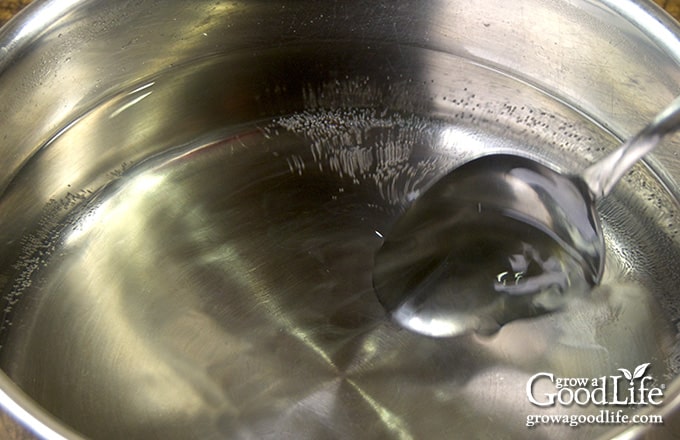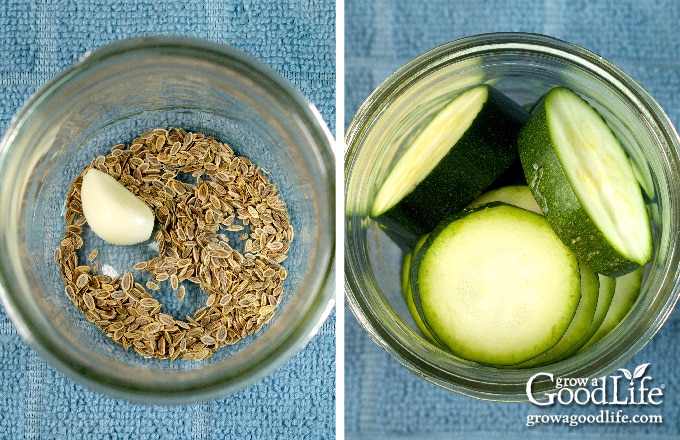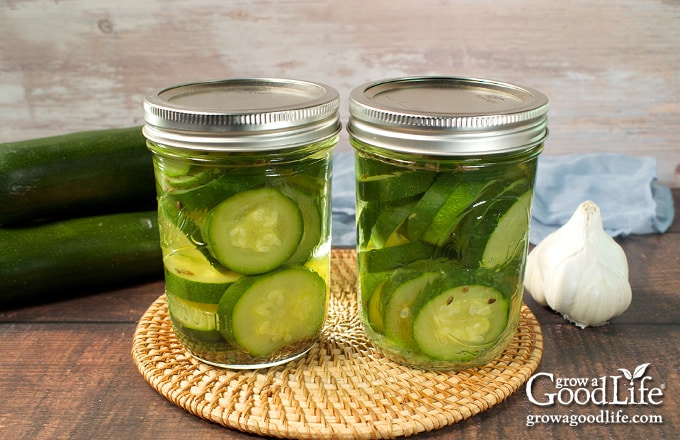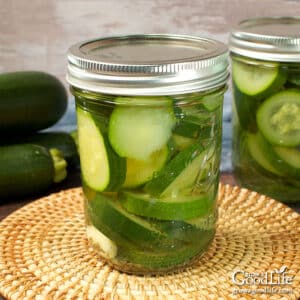Dill Pickled Zucchini Canning Recipe
This post may contain affiliate links, which means that I may receive a commission if you make a purchase using these links. As an Amazon Associate I earn from qualifying purchases.
Discover the tangy and flavorful delight of pickled zucchini with this dill pickled zucchini recipe. Preserve the summer bounty with this easy-to-follow canning recipe featuring fresh zucchini, dill, and a hint of garlic.

If you enjoy the strong taste of dill pickles, you’ll love this delicious recipe for pickled zucchini. During the summer, when zucchini and summer squash are abundant, this easy canning recipe is a perfect way to preserve and enjoy them all year round.
These pickled zucchini are a medley of tanginess, brininess, and herbaceous garlic and dill flavors, offering a delightful twist on traditional pickles. After the pickles mature for a several weeks, they will develop their full flavor. The pickled slices will become tender with the tangy zip of the brine, leaving your taste buds refreshed and tantalized.
These pickles are a great addition to any meal. You can add them to sandwiches, burgers, or wraps to enhance the taste, chop them up and put them in pasta salads to add flavor and texture. They also pair well with charcuterie boards, balancing out the rich flavors of cheese and cured meats. And if you’re looking for a tasty snack, you can enjoy these zucchini pickles straight from the jar.
About the Ingredients
Before we begin, let’s get acquainted with the key ingredients for our dill pickled zucchini and how each plays a vital role in achieving the perfect balance of flavors.
- Zucchini or Summer Squash: When selecting zucchini or summer squash for this recipe, opt for freshly harvested medium-sized fruit, around 8-inches long. Their firm texture makes them ideal candidates for pickling. However, if you find yourself with larger zucchini, don’t worry! You can repurpose them by creating a zesty zucchini relish instead, allowing you to make the most of your harvest.
- Pickling Salt: Also known as canning salt, is an essential ingredient in preserving these pickles. It is free of additives such as iodine or anti-caking agents, ensuring a pure brine and preventing any discoloration or cloudiness in the final product. Its fine texture dissolves easily, allowing for flavor distribution throughout the pickles.
- Vinegar: Use commercial vinegar with at least 5% acidity to achieve the necessary acidity for safe canning. You can use either white vinegar or apple cider vinegar.
- Dill Seeds: These tiny seeds pack a punch of classic dill taste to the pickles. Use seeds less than a year old for the best flavor.
- Water: It’s important to use good quality water when making pickles. Most city tap water contains chemicals and additives that can impact the flavor and quality of the pickles. To ensure the best results, consider filtering your water or using purchased distilled water specifically intended for culinary purposes.
- Garlic: Whole garlic cloves are optional but a fantastic addition. Their pungent and robust flavor infuses the pickles with a slight garlic flavor. Plus, discovering a flavorful pickled garlic clove nestled among the zucchini slices is always a delightful surprise.
If you prefer sweet bread and butter pickle, follow this recipe instead: Sweet and Sour Zucchini Pickles. But if you prefer a pleasantly tart and slightly sour pickle, this dill pickled zucchini recipe is for you. Now, let’s dive into the step-by-step instructions for creating your very own batch.
How to Make Dill Pickled Zucchini
This canning recipe is the “Squash Pickles II” from the So Easy to Preserve book published by the University of Georgia Cooperative Extension.
It is safe to exchange any variety of summer squash with the zucchini, experiment with dried herbs and spices as flavorings, and add some sugar to balance the tart flavor of the brine, but keep the proportions of the zucchini, vinegar, water, and salt the same to ensure the proper chemistry to can your pickles safely.
If you’re new to canning or need a refresher, reviewing this article on water bath canning at the National Center for Home Food Preservation website may be helpful.
While a detailed and printable recipe can be found at the end of this article, let’s walk through the general steps for creating and canning these delectable dill pickled zucchini.
Step 1: Gather Your Canning Equipment
To ensure a smooth canning process, gather all the necessary equipment and get it ready before you begin. The following is a list of items you will need:
- Water bath canner and canning rack: Designed to provide a safe and efficient environment for processing your canned goods. The canner creates a controlled boiling atmosphere, while the rack helps keep the jars secure and prevents them from touching the bottom of the pot. You can use a large saucepot if you don’t have a hot water bath canner. Just make sure the pot is tall enough to fully submerge the jars with a few inches of water above them, providing adequate space to prevent boiling water from splashing out. Place a rack at the bottom of the pot to elevate the jars and shield them from direct heat, reducing the risk of accidental breakage.
- 5 pint-sized canning jars: Use mason jars specifically designed for canning, as they are built to withstand the high heat involved in the canning process. Before use, inspect each jar to eliminate any that show signs of cracks, scratches, or nicks, as these could break during canning.
- Canning Lids and bands: Use new lids for each jar to ensure a proper seal. The bands can be reused as long as they are in good condition, free from rust or deformities.
- Canning tools: A set of canning tools will make your canning process much easier and safer. Make sure you have a jar lifter to handle hot jars, a canning ladle for transferring the brine into the jars, a funnel to prevent spills, and a bubble popper to remove any air bubbles trapped in the jars.
- Basic kitchen supplies: In addition to the canning-specific tools, you’ll also need some basic kitchen supplies. These include a large sauce pot for preparing the pickling liquid, a large bowl for holding the sliced zucchini, measuring cups and spoons, a knife for slicing, a cutting board for food preparation, and plenty of clean kitchen towels for jar prep and cleanup.
With all your canning equipment and kitchen supplies ready, let’s move on to the next step and start bringing these delicious pickles to life.
Step 2: Prepare the Canning Equipment
Start by thoroughly cleaning your jars, lids, bands, and canning tools. Wash them in warm, soapy water, ensuring they are residue-free. Rinse everything well and set aside the lids, bands, and tools to air dry, ready for use when the time comes.
Next, place the rack in the canner, then place the canner on a large burner of your stove. Stand the jars upright inside the pot on the rack, then fill the pot with water, covering the jars entirely. Bring the canner to a gentle simmer, maintaining a temperature of around 180˚F (82˚C) for at least 10 minutes. Keep the jars hot until you are ready to fill them.
Step 3: Prepare Your Ingredients
Give the zucchini a good rinse under clean running water, then slice them into rounds about 1/4 inch thick, ensuring uniformity for even pickling. Peel the garlic cloves, and gather all your ingredients so they are ready to go.
Make the pickling brine by combining the vinegar, water, and salt in a large saucepan, and bring to a boil while stirring to dissolve the salt. Once boiling, simmer for 5 minutes, and then fill your jars.

Step 4: Fill the Jars
Lay a kitchen towel on the counter to help protect the hot jar from temperature swings that can cause it to break. Using the jar lifter, carefully remove a hot jar from the canner, pour the water back into the canner, and place it on the towel. Keep the remaining jars in the canner so they stay warm.
Add one clove of garlic and one teaspoon of dill seeds to the jar. Then pack the prepared zucchini slices into the jar.

Fill the jar halfway with the hot brine, and gently stir the slices using the bubble popper. Add more slices and top it off with additional brine, leaving a 1/2-inch headspace.

Glide the bubble popper through the jar, freeing air pockets and ensuring the zucchini slices are fully submerged in the brine. Adjust the headspace if needed.
Wipe the rim with a damp towel to remove residue, center a lid on the jar, place the band over the lid, and screw it on until fingertip tight. Return the jar to the canner, and repeat the process with the remaining jars filling them one at a time.
Step 5: Process the Jars in the Water Bath Canner
Once all the filled jars are back in the canner, adjust the water level to cover the jars by about 2 inches. Then bring the canner to a full rolling boil over high heat. Once the water boils vigorously, start a timer, and process the jars according to the time specified in the recipe below.
After the processing time is complete, turn off the heat, let the jars settle for about 5 minutes, and then carefully remove them from the canner using the jar lifter and place them on a kitchen towel or cooling rack. Keep the jars upright and don’t touch the lids or tighten the bands. It will take time for the jars to seal completely. Allow the jars to cool undisturbed for 12 to 24 hours. After cooling, test the seals, label the jars, and store the dill pickles in a cool, dark location. Let the pickles stand for about 4 weeks before opening for the flavors to develop.


Dill Pickled Zucchini Canning Recipe
Ingredients
- 4 pounds zucchini or summer squash
- 4 cups white vinegar or apple cider vinegar 5% acidity
- 1 cup water
- 1/4 cup pickling salt
- 5 cloves garlic peeled (optional for flavor, 1 clove per pint jar)
- 5 teaspoons dill seeds 1 teaspoon per pint
Instructions
Prepare the Canning Equipment:
- Wash your jars, lids, screw bands, and canning tools in hot, soapy water. Rinse well to ensure no soap residue remains, and then set them aside to air dry on a clean kitchen towel.
- Place the jar rack into the water bath canner, place jars in the canner, and add water to cover. Bring the canner to a simmer (180˚F) for at least 10 minutes, and keep the jars hot.
Prepare the Ingredients:
- Rinse the zucchini under running water and slice into 1/4-inch rounds.
- Make the pickling brine by combining the vinegar, water, and salt in a large saucepan, and bring to a boil while stirring to dissolve the salt. Once boiling, simmer for 5 minutes, and then fill your jars.
Fill the Jars:
- Spread a kitchen towel on the counter. Use your jar lifter to remove a jar from the canner. Drain and place on the towel. Keep the remaining jars in the canner so they stay warm.
- Add 1 clove of garlic, 1 teaspoon of dill seeds to the jar, and then raw pack the sliced zucchini.
- Use the canning funnel and ladle to fill the jar halfway with hot brine, use the bubble popper to gently stir the zucchini to help pack and separate the slices, and then fill the jar maintaining 1/2 inch of headspace.
- Run the bubble popper through the jar to release air bubbles, wipe the rim, center a lid on the jar, and screw on a band until it is fingertip tight.
- Use your jar lifter to place the jar back into the canner, and repeat with the remaining jars.
Can the Pickles:
- Once the jars are all in the canner, adjust the water level so it is 2 inches over the tops of the jars.
- Cover the canner and bring it to a boil over high heat. Once the water boils vigorously, set a timer, and process the jars for 15 minutes at altitudes of less than 1,000 feet. Adjust processing time for your altitude if necessary (See Note).
- When the processing time is complete, turn off the heat and allow the canner to cool down for 5 minutes.
- Spread a dry kitchen towel on the counter. Remove the cover by tilting the lid away so that steam does not burn your face.
- Use the jar lifter to remove the jars from the canner and place them on the towel. Keep the jars upright, and don’t tighten bands or check the seals yet. Let the jars sit undisturbed for 12 to 24 hours to cool.
- After 12 to 24 hours, check to be sure the jar lids have sealed by pushing on the center of the lid. The lid should not pop up. If the lid flexes up and down, it did not seal. Place the jar in the fridge and use up within a month.
- Remove the bands, wash the jars with soapy water, label, date, and store in a cool, dark location. Allow 4 weeks for the pickles to develop their flavor. Use home-canned jars within 12 to 18 months for the best quality and flavor. This recipe makes about 5-pint jars of dill-pickled zucchini slices.
Notes
Nutrition
40+ Meals in a Jar Pressure Canning Recipes
In this eBook, you will find 50 pressure canning recipes, including 44 meals, along with homemade stocks and bone broths. Recipes include soups, stews, chilis, beans, beef, pork, and poultry. Explore the world of preserving delicious home-cooked meals for all seasons.


What if I do quart jars ? Is process time the same?
Michelle, The processing time for this pickled dill zucchini canning recipe is specifically for pint jars. I double-checked the recipe in the So Easy to Preserve book, and it states pint jars only. This could be because quart jars weren’t tested or didn’t pass testing.
Canning recipes are tested for safety, including pH levels and heat distribution. So, it’s important to follow the recipe’s listed jar sizes to ensure the best and safest results. Generally, going down a jar size is safe, but not up.
Thanks for the recipe! In the pictures it looks like it’s in half pints, but the directions says pints. Which one is it?
Paige, The jars in the pictures are wide-mouth pint jars and the recipe calls for pint jars. However, you could use half-pints if you want smaller portions. The processing time will be the same.